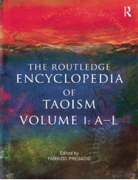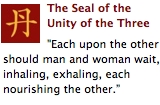Daode jing
Scripture of the Dao and Its Virtue
Reproduced from:
Isabelle Robinet, "Daode jing"
In The Encyclopedia of Taoism, vol. 1, pp. 321-25
Edited by Fabrizio Pregadio
Routledge, 2008
The Encyclopedia of Taoism
● Table of Contents and List of Contributors
Sample Entries
● Daode jing (Scripture of the Dao and Its Virtue)
● daojia (Taoism; "Lineage[s] of the Way")
● daojiao (Taoism; Taoist teaching; "Teaching[s] of the Way")
● Daozang (Daoist Canon) and Subsidiary Compilations
● jiao (Offering)
● jindan (Golden Elixir)
● Lingbao (Numinous Treasure)
● Quanzhen (Completion of Authenticity)
● Shangqing (Highest Clarity)
● Tianshi dao (Way of the Celestial Masters)
The Daode jing (☞ pictures), also known as Laozi, is ascribed to Laozi (☞ pictures), who allegedly gave it to Yin Xi as he left the Middle Kingdom to go to the west. Scholars have long debated its authorship and date. Some think that it is not the work of a single author, some maintain that most of it originated as oral tradition during the Warring States period (403-221), and some suggest that it reached its final form in the late third or the early 2nd century BCE. The Guodian manuscripts, datable to between 350 and 300 BCE, seem to prove that the Daode jing existed at that time in a form very close to the received version.
Editions and Manuscripts
The Daode jing is a short work, sometimes called the "Text in Five Thousand Words" (Wuqian zi wen). Most printed editions derive from one of four main versions: the Yan Zun version, the Heshang gong version (see Laozi Heshang gong zhangju), the Wang Bi version, and the so-called "ancient version" (guben) recovered from a tomb dated to 202 BCE. The latter exists in turn in two distinct but closely related redactions: one edited by Fu Yi (554-639) and another edited by Fan Yingyuan in the Song period. Two Dunhuang manuscripts are also worthy of note: the Suo Dan manuscript, dated 270 CE, which seems to belong to Heshang gong's tradition (Boltz W. G. 1996), and the Xiang'er commentary, which lacks the second half and is not divided into sections. None of these versions yield notable differences from the point of view of meaning.
The text is usually divided into two main parts, called Daojing (Scripture of the Dao) and Dejing (Scripture of Virtue), and into eighty-one sections or chapters (zhang). The two Mawangdui manuscripts, dated to the 2nd century BCE, reverse the sequence of the two parts, placing the Dejing first. The division of the text into eighty-one sections first appears in Heshang gong's version but was not universally accepted until perhaps the Tang period. While some versions are divided into sixty-four, sixty-six, or seventy-two sections, others do not have sections at all. The Guodian slips, in particular, have no division into sections, and while the wording is close to that of the received version, the sequence of the individual passages is often different.
Description
The Daode jing combines sentences, often rhymed, expressing general laws dogmatically asserted with aphorisms that may contain traces of oral sayings, and with instructions on self-cultivation and practical or sociopolitical life. The text is often paradoxical, lyrical, and poetical, containing plays on words, contradictions, ambiguous statements, and enigmatic images. Whether the text proposes an art of ruling or ways of self-cultivation or both, imbued or not with mystical and gnostic views, is an open question that scholars often debate on hypothetical grounds. The following description outlines some of the main features on which scholars generally agree, and that were retained in later Taoism.
The Dao
The main contribution of the Daode jing to Taoism and Chinese thought lies in the new meaning given to the word dao. Usually and broadly understood as "way," "method," or "rule of life," dao takes on for the first time in the Daode jing the meaning of Ultimate Truth, one and transcendent, invisible (yi), inaudible (xi), and imperceptible (wei; sec. 14), not usable and not namable (sec. 1). Since the Dao is beyond all relationship of differentiation and judgement, it cannot be "daoed," or "said" (dao), or practiced as a way. One cannot make use of it, as it is "neither this nor that." However, in spite of this apophatic or negative approach, the Dao, through its Virtue (de), is said to be the source of all life, the "mother," "pervading" (tong), "rich in promises" and the only certain reference point (sec. 25); in this sense, it is "both this and that." All that can be said (dao) and has a name is transient and pertains to the world; only the Dao that has no name is permanent. "Naming" and language, however, are said to be the "mother" of all things.
This dimension of the Dao was retained, with varying emphases, by all schools of Taoism. The Dao is the source of the world, the point to which everything flows, the "treasure of the world" (sec. 62), that by which Heaven and Earth can exist. It has an evanescent and mysterious hypostatized presence that one would like to grasp or see (sec. 14 and 21), and seems to allude to an inner experience resulting from meditation practices aiming at quiescence (see qingjing), and from a multidimensional view of the world. This gives the Daode jing a poetic and lyrical tone, and endows its teaching with a character different from that of other texts of its time.
Ambivalence and Totality
The Daode jing repeatedly names pairs of opposites such as good and evil, high and low, Being and Non-being, naming and not naming, because they all imply and support each other, and pertain to a common whole. As does the Yijing, it points both to the binary structure of our thinking and to the unity from which oppositions proceed, their relativity and their correlation. The consequences drawn from this view, however, are different from those of the Yijing. Whereas the Yijing holds that one can know and prevent coming negative events by understanding the laws of the cosmos, the Daode jing strives to show that thought is by nature dualistic and cannot grasp the Dao, which lies before and beyond any differentiation. The Daode jing not only aims to clarify the inadequacy of language to know the reality of things; in saying that every assumption implies its own negation, it also seeks to unite the two as the reverse and obverse of a coin, or to invert the common order of things so that one can grasp the foundation of all assumptions: for example, to ascend means to begin from the bottom (sec. 39). In doing so, the text sets up a logic of ambivalence that is typical of Taoist thought. Priority is not given to assumption or negation, but to the infinite totality of the Dao where every dualism "has a common origin" (sec. 1).
The Dao encompasses all possibilities because it has no form and no name. Its Virtue is its operation that accomplishes everything in the world. Cosmogonic metaphors connected with mythological themes (Chaos, Mother) call for a Return (fan) to its primordial undifferentiation, and the infant is taken as a model because it has not yet separated from its Mother. In accord with the logic of ambivalence, however, return to the Origin is not separated from return to the ordinary world, as shown by the simple fact that the Daode jing was written for the benefit of human beings.
The Void
The Daode jing's notion of the void (see wu and you) is the first enunciation of an idea that would later evolve and take a major place in Taoism and Chinese thought. In the Daode jing, the void has two levels of functional and existential meaning. Concretely, it is the interstice that allows movement, the receptive hollow in a vessel (sec. 11). As such it also has a cosmic significance: it is the necessary void space that is both the matrix of the world and the place from which the Original Pneuma (yuanqi) can spring forth and circulate. On the human level, the void is mental and affective emptiness, the absence of prejudices and partialities dictated by the desire or will to attain a goal.
The Saint and the Sage Ruler
The vision of the world introduced in the Daode jing is the ideal of the Taoist sage who does not choose between one thing and its opposite, but remains neutral. The saint (shengren) is serene, withdraws from the affairs of the world, and rejects the established values (the ordinary dao or ways) as artificial, in favor of a spontaneous way of life with no virtuous effort toward improvement, and no competition that might introduce disturbances. He lets the Dao and Nature freely operate in him, claiming that if one does so both the world and oneself will go along very well on their own. "Cease all learning," says the sage, the learning that in Confucian terms means striving for something better: one can reach the Truth only by letting it operate naturally (ziran).
The image of the sage ruler in the Daode jing is combined with a "primitivist" tendency that is not unique to this text but can be found in other trends of Chinese thought, including later Taoism. In the Great Antiquity (shanggu, the ideal state of humanity projected into the past), the sage ruler does not interfere and is not even known to the people. Like the Dao, he has no name; like the saint, he lets the laws of nature operate spontaneously so that order is established harmoniously among human beings.
Variety of Interpretations
The Daode jing is open to many interpretations and in fact demands them. The various readings of the commentators have been sometimes classified into schools. For instance, Heshang gong reads the text on two levels, one concerned with self-cultivation and the other with ruling the state; the Xiang'er commentary is an example of its use as a catechism for the Celestial Masters (Tianshi dao); and the Chongxuan (Twofold Mystery) school of thought gives it a Buddhistic and dialectical interpretation. Legalist, Buddhist, Confucian, and Taoist physiological or alchemical interpretations have also been advanced. The Daode jing moreover has been used as a sacred text that, like all sacred writings, must be recited in conjunction with meditation and ritual practices for exorcist and healing purposes.
Isabelle ROBINET





















